
Entoloma sinuatum is a poisonous mushroom found across Europe and North America. Some guidebooks refer to it by its older scientific names of Entoloma lividum or Rhodophyllus sinuatus. The largest mushroom of the genus of pink-spored fungi known as Entoloma, it is also the type species. Appearing in late summer and autumn, fruit bodies are found in deciduous woodlands on clay or chalky soils, or nearby parklands, sometimes in the form of fairy rings. Solid in shape, they resemble members of the genus Tricholoma. The ivory to light grey-brown cap is up to 20 cm (7.9 in) across with a margin that is rolled inward. The sinuate gills are pale and often yellowish, becoming pink as the spores develop. The thick whitish stem has no ring.
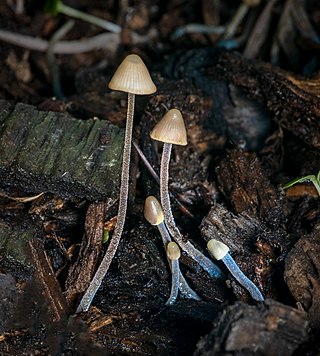
Mycena is a large genus of small saprotrophic mushrooms that are rarely more than a few centimeters in width. The name Mycena comes from the Ancient Greek μύκηςmykes, meaning "fungus". Species in the genus Mycena are commonly known as bonnets.

Aspropaxillus giganteus, also Leucopaxillus giganteus, commonly known as the giant leucopax or the giant funnel, is a saprobic species of fungus in the order Agaricales. As its common names imply, the fruit body, or mushroom, can become quite large—the cap reaches diameters of up to 50 cm (20 in). It has a white or pale cream cap, and is funnel-shaped when mature, with the gills running down the length of the stem. Considered by some to be a choice edible when young, this species has a cosmopolitan distribution, and is typically found growing in groups or rings in grassy pastures, roadside hedges, or woodland clearings. It has been shown to contain a bioactive compound with antibiotic properties.

Mycena haematopus, commonly known as the bleeding fairy helmet, the burgundydrop bonnet, or the bleeding Mycena, is a species of fungus in the family Mycenaceae, of the order Agaricales. It is widespread and common in Europe and North America, and has also been collected in old Japan and Venezuela. It is saprotrophic—meaning that it obtains nutrients by consuming decomposing organic matter—and the fruit bodies appear in small groups or clusters on the decaying logs, trunks, and stumps of deciduous trees, particularly beech. The fungus, first described scientifically in 1799, is classified in the section Lactipedes of the genus Mycena, along with other species that produce a milky or colored latex.

Robert Kühner was a French mycologist most notable for reviewing many forms of agaric genera.
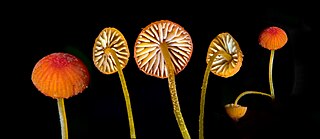
Mycena acicula, commonly known as the orange bonnet, or the coral spring Mycena, is a species of fungus in the family Mycenaceae. It is found in Asia, the Caribbean, North America and Europe. The fruit bodies, or mushrooms, of the fungus grow on dead twigs and other woody debris of forest floors, especially along streams and other wet places. They have small orange-red caps, up to 1 cm (0.4 in) in diameter, held by slender yellowish stems up to 6 cm (2.4 in) long. The gills are pale yellow with a whitish edge. Several other Mycena species look similar, but may be distinguished by differences in size and/or microscopic characteristics. M. acicula is considered inedible because of its small size.

Mycena adscendens, commonly known as the frosty bonnet, is a species of fungus in the family Mycenaceae. The fungus produces small white fruit bodies (mushrooms) with caps up to 7.5 mm (0.3 in) in diameter that appear to be dusted with sugar-like granules. Caps are supported by thin, hollow stems up to 20 mm (0.8 in) long, which are set on a disc-like base. Its distribution includes Europe, Turkey and the Pacific coast of the United States. The fruit bodies grow on fallen twigs and other woody debris on the forest floor, including fallen hazel nuts. The variety carpophila is known from Japan. There are several small white Mycena species that are similar in appearance to M. adscendens, some of which can be reliably distinguished only by examining microscopic characteristics.

Mycena aetites, commonly known as the drab bonnet, is a species of mushroom in the family Mycenaceae. First described as Agaricus aetites by Swedish mycologist Elias Magnus Fries in 1838, it was assigned its current name in 1872 by Lucien Quélet. This rare mushroom is found in Europe.
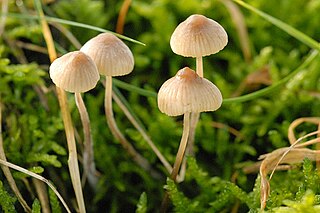
Atheniella flavoalba, which has the recommended name of ivory bonnet in the UK, is a species of agaric in the family Cyphellaceae. The cap is initially conical, before becoming convex and then flat; it may reach up to 1.5 cm (0.6 in) across. The cap is ivory-white to yellowish white, sometimes more yellowish at the center. The tubular stems are up to 8 cm (3.1 in) long and 2.5 mm (0.10 in) thick, and have long, coarse white hairs at their bases. Atheniella flavoalba is found in Europe, the Middle East, and North America, where it grows scattered in pastures or in dense groups under conifers and on humus in oak woods.

Mycena inclinata, commonly known as the clustered bonnet or the oak-stump bonnet cap, is a species of mushroom in the family Mycenaceae. The doubtfully edible mushroom has a reddish-brown bell-shaped cap up to 4.5 cm (1.8 in) in diameter. The thin stem is up to 9 cm (3.5 in) tall, whitish to yellow-brown at the top but progressively becoming reddish-brown towards the base in maturity, where they are covered by a yellowish mycelium that can be up to a third of the length of the stem. The gills are pale brown to pinkish, and the spore print is white. It is a widespread saprobic fungus, and has been found in Europe, North Africa, Asia, Australasia, and North America, where it grows in small groups or tufts on fallen logs and stumps, especially of oak. British mycologist E.J.H. Corner has described two varieties of the mushroom from Borneo. Lookalike species with which M. inclinata may be confused include M. galericulata and M. maculata.
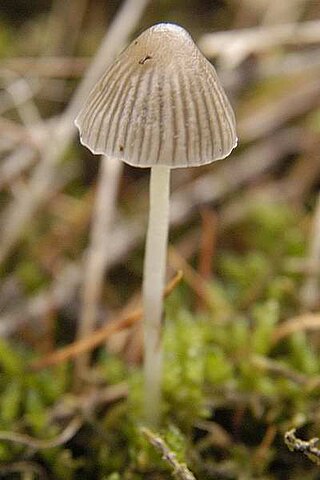
Mycena leptocephala, commonly known as the nitrous bonnet, is a species of fungus in the family Mycenaceae. The mushrooms have conical grayish caps that reach up to 3 cm (1.2 in) in diameter, and thin fragile stems up to 5 cm (2.0 in) long. The gills are gray and distantly spaced. The spores are elliptical, typically measure 7–10 by 4–6 μm, and are white in deposit. When viewed under a light microscope, the gills have abundant spindle-shaped cystidia on the gill edges, but few on the gill faces. The mushroom is found in North America, Asia, and Europe where it grows singly or in groups on conifer needles, cones and sticks on the forest floor. It has a distinctive odor of bleach; the edibility is unknown. Similar species include Mycena alcalina, M. austera, and M. brevipes.

Mycena polygramma, commonly known as the grooved bonnet, is a species of mushroom in the family Mycenaceae. The inedible fruit bodies are small, pale gray-brown mushrooms with broadly conical caps, pinkish gills. They are found in small troops on stumps and branches of deciduous and occasionally coniferous trees. The mushroom is found in Asia, Europe, and North America, where it is typically found on twigs or buried wood, carrying out its role in the forest ecosystem by decomposing organic matter, recycling nutrients, and forming humus in the soil. M. polygramma contains two uncommon hydroxy fatty acids and is also a bioluminescent fungus whose intensity of light emission follows a diurnal pattern.

Mycena vitilis, commonly known as the snapping bonnet, is a species of inedible mushroom in the family Mycenaceae. It is found in Europe and North America, where it grows on the ground among leaves in damp places, especially under alder. The small pale gray to whitish fruit bodies are usually attached to small sticks buried in the leaves and detritus. They are distinguished by their long, slender stems that root into the ground, and by the grooved cap that reaches diameters of up to 2.2 cm (0.9 in). The grayish-white gills on the underside of the cap are distantly spaced, and adnately attached to the stem. M. vitilis contains strobilurin B, a fungicidal compound with potential use in agriculture.

Mycena renati, commonly known as the beautiful bonnet, is a species of mushroom in the family Mycenaceae. It was described by French mycologist Lucien Quélet in 1886. It has been collected in Austria, Uşak Province in Western Turkey, and Yugoslavia.

Mycena overholtsii, commonly known as the snowbank fairy helmet or fuzzy foot, is a species of fungus in the family Mycenaceae. The mushrooms produced by the fungus are relatively large for the genus Mycena, with convex grayish caps up to 5 cm (2 in) in diameter and stems up to 15 cm (6 in) long. The gills on the underside of the cap are whitish to pale gray, and initially closely spaced before becoming well-spaced at maturity after the cap enlarges. The mushrooms are characterized by the dense covering of white "hairs" on the base of the stem. M. overholtsii is an example of a snowbank fungus, growing on well-decayed conifer logs near snowbanks, during or just after snowmelt. Formerly known only from high-elevation areas of western North America, particularly the Rocky Mountain and Cascade regions, it was reported for the first time in Japan in 2010. The edibility of the mushroom is unknown. M. overholtsii can be distinguished from other comparable species by differences in location, or spore size.

Mycena stylobates, commonly known as the bulbous bonnet, is a species of inedible mushroom in the family Mycenaceae. Found in North America and Europe, it produces small whitish to gray fruit bodies with bell-shaped caps that are up to 15 mm (0.6 in) in diameter. The distinguishing characteristic of the mushroom is the fragile stipe, which is seated on a flat disk marked with distinct grooves, and fringed with a row of bristles. The mushrooms grow in small troops on leaves and other debris of deciduous and coniferous trees. The mushroom's spores are white in deposit, smooth, and ellipsoid-shaped with dimensions of 6–10 by 3.5–4.5 μm. In the development of the fruit body, the preliminary stipe and cap structures appear at the same time within the primordium, and hyphae originating from the stipe form a cover over the developing structures. The mycelia of the mushroom is believed to have bioluminescent properties.

Mycena aurantiomarginata, commonly known as the golden-edge bonnet, is a species of agaric fungus in the family Mycenaceae. First formally described in 1803, it was given its current name in 1872. Widely distributed, it is common in Europe and North America, and has also been collected in North Africa, Central America, and Japan. The fungus is saprobic, and produces fruit bodies (mushrooms) that grow on the floor of coniferous forests. The mushrooms have a bell-shaped to conical cap up to 2 cm in diameter, set atop a slender stipe up to 6 cm long with yellow to orange hairs at the base. The fungus is named after its characteristic bright orange gill edges. A microscopic characteristic is the club-shaped cystidia that are covered with numerous spiky projections, resembling a mace. The edibility of the mushroom has not been determined. M. aurantiomarginata can be distinguished from similar Mycena species by differences in size, color, and substrate. A 2010 publication reported the discovery and characterization of a novel pigment named mycenaaurin A, isolated from the mushroom. The pigment is responsible for its color, and it has antibiotic activity that may function to prevent certain bacteria from growing on the mushroom.
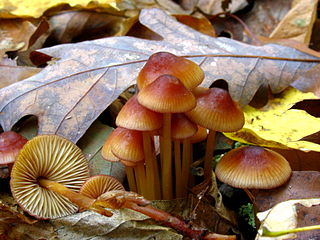
Mycena atkinsoniana is a species of agaric fungus in the family Mycenaceae. It is one of the so-called "bleeding mycenas" that will ooze yellow to orange juice when injured. Other distinguishing features include the upper stem surface that is decorated with tiny purplish-brown fibers, and the gills, which are pale yellow with maroon edges. The reddish-brown caps are smooth with a grooved margin, and up to 3 cm (1.2 in) wide. Mycena atkinsoniana is known from the United States and Canada, where it grows scattered or in groups on leaf litter in forests during the summer and autumn. It was originally described from collections associated with beech, but it is also frequently found under eastern North American oaks.

Mycena tintinnabulum is a European species of agaric fungus in the family Mycenaceae. The mycelium, but not the fruit body, is bioluminescent.

Mycena purpureofusca, commonly known as the purple edge bonnet, is a species of agaric fungus in the family Mycenaceae. First described by Charles Horton Peck in 1885, the species is found in Europe and North America, where it grows on the decaying wood and debris of conifers, including cones. Fruit bodies have conical to bell-shaped purple caps up to 2.5 cm (1 in) set atop slender stipes up to 10 cm (4 in) long. The mushroom is named for the characteristic dark greyish-purple color of its gill edges. In the field, M. purpureofusca mushrooms can usually be distinguished from similar species by characteristics such as the dark purple gill edges, the deep purple cap center, and its cartilagineous consistency. The fungus contains a laccase enzyme that has been investigated scientifically for its potential to detoxify recalcitrant industrial dyes used in textile dyeing and printing processes.




















